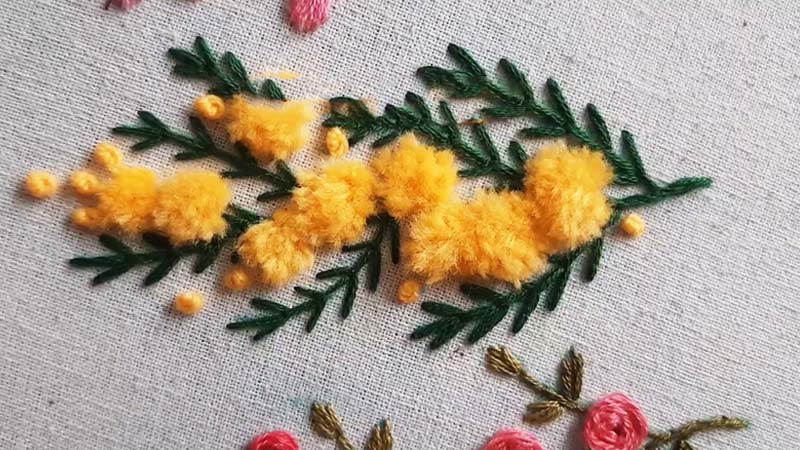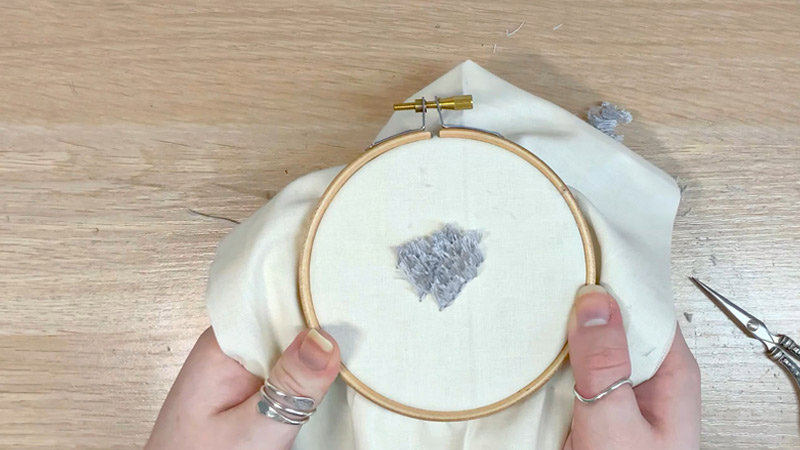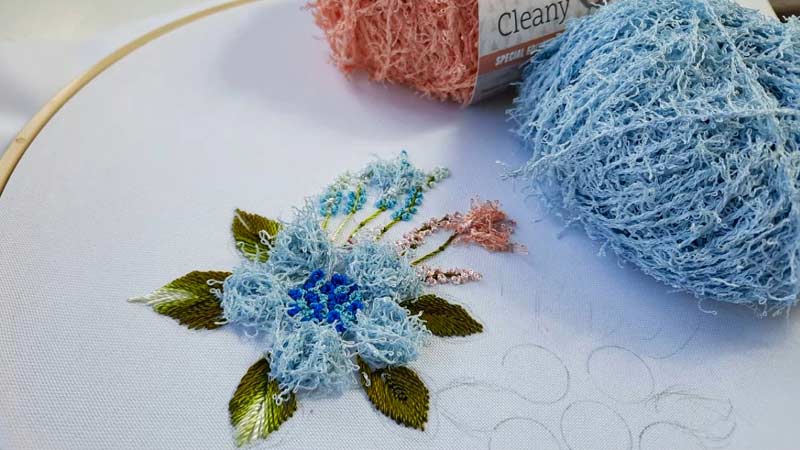Embroidery, with its myriad techniques and stitches, offers a canvas for creativity and artistic expression. Among the diverse styles, one particular facet captures the essence of the softness and texture of fluffy embroidery.
This enchanting form of needlework introduces a tactile quality, creating designs that must be touched and admired.
As we explore the question, “What is fluffy embroidery called?” we delve into the various stitches and methods that crafters employ to bring a sense of fluffiness and dimension to their embroidered creations.
From tufting to chenille, each technique contributes to the allure of fluffy embroidery, transforming thread and fabric into a tactile masterpiece.

What Is Fluffy Embroidery Called?
The world of embroidery embraces a variety of techniques, adding texture and dimension to fabric. When it comes to creating a fluffy or fuzzy effect, several embroidery methods can be employed, each known for its unique characteristics.
Crewel Embroidery
Crewel embroidery utilizes wool threads, creating a plush and textured appearance. This technique involves using a variety of stitches to form intricate patterns, resulting in a rich and dimensional surface.
Bouclé Stitch Embroidery
The bouclé stitch, characterized by its looped texture, contributes to a fluffy embroidery effect. It involves creating loops on the fabric, offering a tactile and visually interesting embellishment.
Tufting Embroidery
Tufting involves creating small loops or tufts on the fabric’s surface. This technique creates a plush, three-dimensional texture resembling a soft, fluffy surface, making it ideal for decorative elements.
Chenille Embroidery
Chenille embroidery involves layering and cutting threads to create a fuzzy, velvety texture. This technique is popular for creating a soft and plush finish on various fabrics.
Turkey Work Embroidery

Also known as Ghiordes Knot or the Turkey Work stitch, this technique involves creating long loops resembling plush carpets. It’s commonly used to achieve a fluffy texture, especially in projects like animal fur or fuzzy landscapes.
French Knot Embroidery
While not inherently fluffy, French knots can contribute to a textured surface; when densely stitched, French knots create a raised and tactile effect, adding a subtle touch of fluffiness to the design.
Loop Stitch Embroidery
As the name suggests, the loop stitch creates loops on the fabric. This stitch can be varied in length to achieve a fluffy or fuzzy appearance, making it suitable for adding texture to specific elements in embroidery projects.
Achieving a fluffy or fuzzy effect in embroidery involves mastering specific stitches and techniques like crewel embroidery, bouclé stitch, tufting, Turkey work, chenille, French knots, and loop stitches.
Each method contributes to the delightful world of fluffy embroidery, providing diverse options for texture and visual interest in needlework projects.
How To Make Fluffy Embroidery?

Achieving a fluffy effect in embroidery adds dimension and texture to your needlework projects. Several simple methods can help you easily create a plush and tactile finish.
Crewel Embroidery with Wool Threads
Opt for wool threads in crewel embroidery to introduce a fuzzy texture. The thickness of the wool creates a soft and fluffy surface, enhancing the overall tactile appeal.
Bouclé Stitch for Looping Texture
Utilize the bouclé stitch, known for its looped texture. By creating loops on the fabric, this stitch adds a delightful fluffiness, perfect for capturing the essence of soft textures.
Tufting Technique
Incorporate the tufting technique by creating small loops or tufts on the fabric’s surface. This simple method instantly introduces a plush, three-dimensional effect.
Turkey Work for Furry Textures
Embrace Turkey Work is a stitch that involves creating long loops resembling a plush carpet. This method is particularly effective for achieving a fuzzy texture, making it ideal for projects featuring animal fur or fuzzy landscapes.
Chenille Embroidery with Layering
Employ chenille embroidery, where layering and cutting threads produce a fuzzy, velvety surface. This straightforward technique adds a soft and plush finish to various fabrics.
French Knots for Textured Detail
Utilize French knots strategically for a textured surface. Densely stitched French knots can contribute to a raised and tactile effect, adding subtle fluffiness to specific elements in your embroidery.
Loop Stitch for Variable Fluffiness
Experiment with the loop stitch, adjusting its length to control the level of fluffiness. This versatile stitch allows you to tailor the texture, making it suitable for various fluffy elements in your embroidery projects.
Incorporating these simple methods, such as crewel embroidery with wool threads, bouclé stitching, tufting, Turkey Work, chenille embroidery, French knots, and loop stitches, empowers you to infuse your embroidery projects with delightful fluffiness and visual interest.
7 Fluffy Embroidery Thread Patterns
Adding a touch of fluffiness to your embroidery projects can elevate the visual appeal and tactile experience. Explore these five fluffy embroidery thread patterns to infuse your creations with texture and dimension.
1. Bouclé Blooms

Create blooming flowers using the bouclé stitch, forming textured petals with looped threads. This fluffy embroidery technique adds a playful and whimsical touch to floral designs.
2. Cloudlike Chenille Clouds
Craft fluffy clouds using chenille embroidery and layering threads to mimic clouds’ soft, billowy appearance. This technique enhances the dreamy and ethereal quality of sky-themed embroideries.
3. Velvet Waves with Velvet Stitch
Employ the velvet stitch to produce undulating waves resembling a velvety sea surface. This fluffy embroidery pattern brings a luxurious texture to ocean-inspired designs, creating a captivating visual effect.
4. Cozy Tufted Animals
Use tufting techniques to create adorable and fluffy animals. By adding small loops or tufts strategically, you can replicate the appearance of fur, making your embroidered animals irresistibly cuddly.
5. Whimsical Fluff Forest
Bring a touch of enchantment to your embroidery with a fluffy forest scene. Utilize the fluffy stitch to depict trees, foliage, and woodland creatures, transforming your fabric into a whimsical and tactile woodland tableau.
6. Cuddly Teddy Bears with Turkey Work
Craft cuddly teddy bears using Turkey Work, creating long loops that resemble plush fur. This fluffy embroidery pattern lends itself beautifully to projects where a cozy and huggable texture is desired.
7. Furry Fringe Fields
Experiment with embroidery fringe stitches to create fields of textured fur. This fluffy embroidery pattern is perfect for adding realistic animal textures, creating a charming and lifelike effect in your needlework.
Incorporating these fluffy embroidery thread patterns into your projects allows you to explore a world of texture and visual interest, transforming your creations into delightful and touchable works of art.
FAQs
Are there specific stitches that contribute to the fluffiness in embroidery?
Stitchings like bouclé, tufting, and chenille are renowned for introducing a fluffy texture to embroidery. Each stitch offers a distinct approach to achieving a soft and dimensional effect.
Can fluffy embroidery be used for creating realistic textures, like animal fur?
Yes, fluffy embroidery techniques, especially Turkish work or tufting, are excellent for replicating realistic textures, such as animal fur. These stitches create a tactile and lifelike appearance.
Are there variations in fluffy embroidery for different themes or designs?
Certainly, fluffy embroidery is versatile and adaptable to various themes. Whether creating cloudlike motifs, cuddly animals, or textured waves, different techniques can be employed to suit the desired design.
What materials are commonly used in fluffy embroidery to achieve a soft texture?
Soft and plush threads, such as wool or textured yarns, are commonly used in fluffy embroidery. These materials enhance the tactile quality and contribute to the overall fluffiness of the stitched design.
Can beginners attempt fluffy embroidery techniques, or are they more advanced?
While some fluffy embroidery techniques may require practice, beginners can certainly experiment with stitches like bouclé or simple tufting. Starting with smaller projects allows for gradual skill development and exploration of the fluffy texture.
Conclusion
The world of embroidery unveils a spectrum of techniques that contribute to the fluffy, dimensional quality of needlework.
The answer to “What is fluffy embroidery called?” encompasses a range of stitches like tufting, chenille, and more, each offering its unique texture and visual appeal.
Whether creating cuddly animals, velvety waves, or cloudlike motifs, fluffy embroidery adds an extra layer of charm to the art form.
As crafters explore these techniques, they unlock the potential to transform ordinary fabric into a cozy, touchable masterpiece that captures the eye and invites a tactile connection with the stitched creations.
Leave a Reply